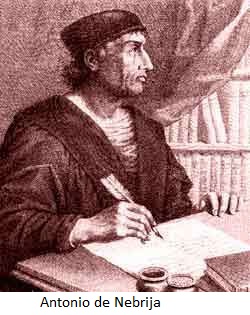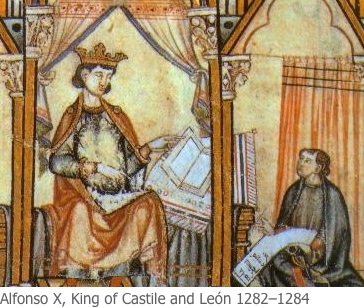1. Introduction
Castilian
Spanish – not any one localized dialect of it, but a supra-regional or
‘neutral’ variety – supplies the model for standard Spanish in Spain (some
Latin Americans also regard Castilian usage as being the most prestigious,
although in practice the majority of Latin American speakers now gravitate towards regional or even national
linguistic norms). The sociolinguistic pre-eminence of Castilian usage stems from the way in which Spain the nation state came into being.
Castile emerged as the driving force behind the Reconquest and was the senior
partner in the fifteenth-century union with Aragon, which effectively resulted in
the formation of modern Spain. It was only to be expected that the speech
patterns that were characteristic of Castile would form the basis for any
subsequent standardization of the national language.
By the Late Middle Ages, Spanish – understood as the Castilian variety of Ibero-Romance – already had a reasonably well-established writing system, the fruit of several centuries of experimentation and evolution. This was consolidated and standardized by the scribes at the Toledo royal court in the second half of the thirteenth century under the auspices of Alfonso X el Sabio, depicted below.
The following extract provides an illustration of the written Spanish of the Alfonsine period:
El segundo iuego dar la xaque con el Roque prieto que esta en la casa del alffil prieto poniendo lo en la tercera casa del alffil blanco & tomar lo a el Rey blanco por fuerça (Libro del ajedrez, dados y tablas, fol. 42r)
‘The second move will put it [the white king] in check with the black rook, which is in the black bishop’s square, by moving it to the white bishop’s third square, where the white king is obliged to take it.’
The spelling system embodied in the textual output of the Alfonsine scriptorium forms the basis of the modern spelling system, although, unsurprisingly, the orthography has been periodically reformed to take account of changes in pronunciation. Nevertheless, the implicit assumption that the written language models Castilian usage has remained broadly unchanged.
Finally, it can be noted that Spanish/Castilian was one of the first Romance languages to be made the subject of a grammatical treatise, namely Nebrija’s Gramática de la lengua castellana (1492). Although Nebrija was himself from Seville, the text is intended as a description of the national language and no doubt contributed to the construction of a standard language ideology, based around the Castilian variety.
2. Phonetics and phonology
Given the way standard Spanish is defined, features that are general in Castilian usage, particularly in terms of pronunciation, are likely to belong to the standard system enshrined in the normative manuals. Two possible candidates for non-standard but widespread Castilian phonological tendencies are the following:
- the articulation of word-final /d/ as [θ], as in [saˈluθ] salud ‘health’, [bonˈdaθ] bondad ‘goodness’
- the articulation of /s/ as [ɾ] before a dental consonant, as in [loɾˈðjentes] los dientes ‘the teeth’ and [loɾθaˈpatos] los zapatos ‘the shoes’.
Almost uniquely in the Spanish-speaking world, Castilian /s/ is apical, in the sense that it is articulated with the tip of the tongue rather than with the tongue’s blade (the topside area just behind the tip). Given that the upper articulator is the alveolar ridge, Castilian /s/ can be classified as being apical alveolar (an alternative term is retracted alveolar). There is no bespoke IPA symbol for this sound but the composite symbol shown below, constructed using the IPA’s apical diacritic, can be used for it:
From the auditory point of view, the apical Castilian /s/ can be recognized by the fact that it has a ‘duller’ sound or lower pitch than the laminal (denti-alveolar) /s/ that is found in Andalusia and most parts of Latin America (this latter sound also occurs in standard French, as the phonological correlate of orthographic s-, -ss- and ç). On the other hand, the pitch of the apical /s/ is not as low as for
palato-alveolar [ʃ], the sound foreign learners of
Spanish often p roduce when attempting to replicate a Castilian /s/. Among speakers who have emigrated
from Andalusia to Castilian cities (especially Madrid), /s/ pronunciation is
usually one of the last speech variables to be adjusted in any process of phonetic accommodation.
roduce when attempting to replicate a Castilian /s/. Among speakers who have emigrated
from Andalusia to Castilian cities (especially Madrid), /s/ pronunciation is
usually one of the last speech variables to be adjusted in any process of phonetic accommodation.
Another feature that is associated primarily with Castilian Spanish, having been lost in Andalusian Spanish and in most Latin American varieties, is the traditional distinction between the palatal lateral /ʎ/, corresponding to the digraph ll, and the palatal fricative /ʝ/, corresponding to the letter y. However, even in the Castilian dialect area not all speakers observe the distinction, many speakers neutralizing the opposition in favour of /ʝ/, a phenomenon known as yeísmo. It is difficult to make accurate predictions about
The
remaining features that merit comment are fairly localized. With regard to vowels, the most important divergence from standard
Spanish consists in the raising of the mid vowels in unstressed final
syllables, as in [ˈjelu] hielo ‘ice’
and [ˈletʃi] leche ‘milk’. This phenomenon appears to reflect the influence of
Asturian and is associated mainly with western Cantabria.
In terms of consonants, the most significant dialectalism is the so-called r asibilada (‘assibilated r’), which is common in the Spanish of north central and north-western areas of Spain (Alava, La Rioja, Navarre, Aragon). The term r asibilada refers to the occurrence of a voiceless or voiced retroflex sibilant ([ʂ] or [ʐ]) where standard Spanish has [ɾ] or [r]. Given that [ʂ] is accoustically very similar to the apical /s/ of Castilian Spanish, the voiceless variant of the assibilated r may resemble an s. For example, the infinitival form decir ‘to say’ may be almost indistinguishable in assibilating dialects from the conjugated form decís ‘you say’, both approximating to /deˈθis/.
The assibilation of /ɾ/ and /r/ is common also in Latin America and there, as
in northern Spain, the distribution of the voiceless and voiced variants
usually follows a common pattern. The voiceless variant [ʂ] usually appears in syllable-final position or
after a voiceless stop, as in [ˈpaʂke] parque ‘park’ and [ˈpʂopjo] propio ‘own’. One common instance of this pattern, viz. [tʂ], may be barely
distinguishable from the affricate [tʃ], with the result that words such
as otro ‘other’ and ocho ‘eight’ may approach homonymy in
assibilating dialects. The voiced variant [ʐ] tends to appear word-initially or
intervocalically (in words spelled with -rr-),
as in [ˈʐoxo] rojo ‘red’ or [ˈpeʐo] perro ‘dog’.
3. Grammar
Surprisingly perhaps,
given the link between Castilian Spanish and Standard Spanish, many speakers in Castile
exhibit leísmo and/or laísmo. The first of these terms refers to the use of le (and less commonly les) in the function of direct object, while the second refers to the use of la and las in the function of indirect
object. According to the ‘standard’ system of object clitics in Spanish, la and las are accusative or direct object pronouns only, while le and les are in principle reserved for the dative or indirect object function. This reflects the fact that la and las, together with lo and los, descend from accusative forms of the Latin personal pronoun, whereas le and les descend from dative forms.
Leísmo is most common when the
reference is to a human being, but it is quite frequent also when the
antecedent is any animate entity. In some parts of Old Castile the phenomenon
is related to the count–mass distinction, with le(s) being used whenever the antecedent is a (masculine) count
noun (i.e. a noun that is used of discrete objects, such as niño ‘child’, árbol ‘tree’, perro ‘dog’, coche ‘car’ etc.). Compare,
for example, (1) and (2) below:
(1) El coche no le mueven de ahí.
‘They don’t move the car from there.’
(2) El café ya no lo pruebo.
‘I no longer drink coffee.’
|
Masculine
|
Feminine
|
||||
Human referent
|
Non-human referent
|
|||||
sing. |
plu. |
sing. |
plu. |
sing. |
plu. |
|
Direct object
|
le |
les
|
lo
|
los
|
la
|
las
|
Indirect
object
|
lo |
los |
||||
A phenomenon that is characteristic of northern Castile, Cantabria and the Basque Country involves routinely using the conditional form in place of the past subjunctive:
(3) Si haría buen tiempo, iríamos a la ermita.
‘If the weather was good, we would go to the chapel in the country.’(4) Le compré los caramelitos para que se estaría callado.
‘I bought him the sweets so that he would be quiet.’(5) Yo me fui antes de que llegaría.
‘I left before he/she arrived.’(6) Ojalá me tocaría el gordo.
‘If only I won the lottery.’(7) No encontré a ninguno que lo haría.
‘I found no one who would do it.’
With the
possible exception of (7), each of the above sentences would be regarded as
ungrammatical by speakers from outside the far north of Spain.
An
additional feature of northern varieties is a preference for the preterite in
cases where speakers from Madrid, say, or southern Spain would be likely to use
the perfect. Thus, for example, ¿Comiste
ya? ‘Have you eaten yet?’, Eso no lo
oí yo ‘I haven’t heard that’.
4. Lexicon
As is to be expected, there are few lexical items that are general in Castile and yet do not belong to the standard vocabulary. Most studies of the Castilian lexicon have highlighted items whose use is limited to small geographical areas, such as individual provinces. On the other hand, most manuals report the widespread use of caer ‘to fall’ and quedar ‘to remain’ as transitive verbs:
(8) Me cayó el caballo en carnaval.
‘The horse threw me at the carnaval.’(9) Quedé el libro sobre la mesa.
‘I left the book on the table.’
References
Holmquist, Jonathan. 1985. ‘Social Correlates of a Linguistic Variable: a study in a Spanish village.’ Language in Society 14, 2:191–203.
